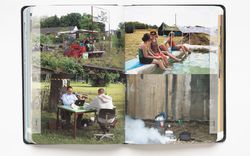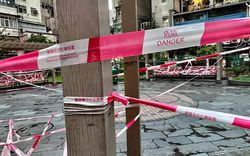The Writing of One Continuous Line
Vikramāditya Prakāsh on the archive of Āditya Prakāsh
My father died in August 2008 quite unexpectedly. I happened to be visiting India at that time and after a day together, I put him on the train to Bombay with the troop of young street performers on their way to present a work-shopped play entitled Zindigi Retire Nahin Hoti (Life Never Retires) in which he was the protagonist. He boarded the train in Chandigarh at 8pm and half a day later, at about 4am, he suffered a heart attack on the train and died at Ratlam, a city in the middle of India.
By the time my mother and I got the news it was 6am, and by the time we figured out what had to be done, another twenty-four hours later had gone by when his body arrived in a black coffin, also by train, back in Chandigarh. By then, scores of relatives and friends had already gathered, and the news had spread quite far into the local Chandigarh community or at least in the community of Chandigarh old timers who remembered the making of the city in the 1950s and 1960s. By the time the cremation rites had taken place, I was already reeling under the largely self-imposed pressures of inheritance. Being a demanding A-list father’s only son in India is always a perilous expectation and in the case of my father and I, we had a strangely mirrored and yet chequered relationship (perhaps quite typical in terms of the oedipal architecture as described by Sigmund Freud).
After the dust settled, I finally ventured into his office and painting studio to examine what was there. My father had left his things, or at least I so believed, in a mess. Nothing was indexed, everything was in piles, there was no obvious hierarchy or order, other than in his painting studio where his hundreds of drawings and paintings were neatly stacked in drawers, kept safe, his treasured possessions.
I backed out of the room, and it took me nearly five years of repeated trips from the United States to bring some recognizable order to his papers, drawings, correspondence, and multimedia objects. Most of this work, in the first stage, consisted of separating what I considered to be chaff from the things that might have some archival value, and here I made the early decision to base my selection on what I, as an architectural historian, considered to be things of value rather than trying to imagine or post anticipate what my father would have considered of value. I estimate that I threw away roughly fifty percent of his papers and about twenty-five percent of the sheets amongst the drawings. Duplicates and general publications received from others from amongst the papers, and any drawing not authored and modified by my father were tossed. I kept all the art. My mother wasn’t too happy, as she informed me later, with all the things I tossed.
But the work of organizing all the paperwork and drawings into something resembling an archive finally took place in the summer of 2017 when, by a lucky confluence, I had the assistance of three young recent graduates. Lakshmi Krishnaswami was my student from the University of Washington and had just finished her master’s thesis on my father’s life and work. Vishal Khandelwal, who is now Assistant Professor at Harvard, was a PhD student at Michigan in Art History. He was simply interested in seeing what was available in the archive. Eashan Chaufla was my friend’s son and had just returned from RISD with a design degree and was at loose ends. I had just finished adding two stories to my father’s house so there was enough room for them all to sleep there. Every morning for a month we would wake up have breakfast together and then sit around a large table and go through the day’s findings. Vishal went through all the paperwork and tried to at least give it a label. Lakshmi dealt with the art, and Eashan took on the drawings and all the multimedia objects. Eventually Ishan fell so in love with the archive and its narrative, that he and his mother ended up buying our house for themselves, when it came time to sell.1
I had left India in 1986 to go to graduate school in the United States, as a consequence of which, the last thirty years of my father’s life were something of an enigma to me. Most of it, as he himself accounted to me, was devoted to art. But as I sifted through the archives, what was a surprise to me was how much more it contained, not only from his later years, but also from his early life—which is to say, his life well before I was born, from the 1940s and 1950s. I was amazed to find his old diaries, lots of photographs, a few boxes full of old memorabilia like exhibition catalogues along with bunches of treasured letters and postcards. This was the time he spent in the United Kingdom studying architecture and art, when he developed a love for theatre, when he fell in and out of love, and when he left the potentially lucrative opportunity to live permanently in the UK to join the Chandigarh capital project seizing the opportunity to both work with Le Corbusier and Pierre Jeanneret—who were of course already the international celebrity architects at that time, and perhaps, more importantly, to be part of the ambitious Nehruvian project of rebuilding India from its bootstraps. This work of the first generation of Indian modernists, who came of age in the early years of the Indian nation state, is what is now being described as the “Third Epoch”, as first characterized by the contemporary artist cum theorist Badri Narayan (and developed recently by the gallerist Mortimer Chatterjee and poet cum theorist Ranjit Hoskote).
-
It was in this context that my friend Maristella Casciato put me in touch with Martien de Vletter and set up the pathway for the acquisition of the archive at CCA. We were able to use the event of my mother’s transfer to the United States as a permanent resident to move the archive to the United States, from where it came to Montréal. ↩
Surprisingly, of his time working on the Chandigarh Capital Project, there was not that much. I found one original Le Corbusier watercolour, casually tucked amongst the papers, and a bunch of retrospective drawings documenting that hiss work with Le Corbusier on the School of Art and on the Modulor whilst designing the College of Architecture. Most of the archive from that period was devoted to his work on his most favourite building, the Tagore Theatre, his first major independent project built for the Tagore centenary in 1962.
A significant section of the archive was devoted to his years in Ludhiana, a small town two hours from Chandigarh in North India where he was building the several agricultural universities as part of what came to be known as the “Green Revolution” in the 1960s. From the papers, drawings, and correspondence, it was clear that this was the period of his professional life that he had invested deeply in. Moving away from Chandigarh and moving out from the huge shadow of Le Corbusier and Pierre Jeanneret, was clearly his self-assigned opportunity to define himself, to express himself as his own man, building his vision of an Indian modernism. He bought cameras, a tape recorder, and a slide projector from his visiting scientist friends and set about documenting his surroundings and thoughts. The photographs and recordings and photo albums from this time carry the restless energy of a young mind in search of new answers. My father was in his 40s then and as I went through the material, I felt close to him—reading into his presentations my own sense of high self-expectations at that same age.
The bulk of my father’s photographs from Ludhiana dwelt on the contrast—or was it the continuity? —between the modernist architecture that he was designing and the agro-rural peri-urban economy that surrounded him. (This is also the contrast that I later found in the so-called Album Punjab that documents Le Corbusier’s first visit to India.) In my father’s case, the task of reconciling this difference became the centre of the long list of papers, research project, and most importantly the urban proposals that occupied his time in the 1970s as Principal of the Chandigarh College of Architecture, the institution that he had designed. Simultaneously trying to advance his vision of a radical new modernism in contradistinction to the culturalist mood of the time, I remember in vivid detail his conflicts with the other architects of India who were focused instead on producing aesthetic Indian modernism in response to the dictates and expectations of postmodernism. The fantastic series of urban drawings and analysis that he prepared at this time were an eye opener for me, as were his extensive writings and publications.
The last two decades of his life in the 1990s and early 2000s are dominated by the art and the surprisingly large number of architectural design projects that he took on as a private practitioner. The story of his resolve in the period of neoliberal India and a globalizing world is one that I found difficult to connect with and theorize given the radically different direction that my own intellectual and personal life took in this time as a postcolonial scholar and an academic in the United States. It is my hope that other scholars will be able to situate and articulate these better than me. From my vantage it was his hobbies rather than his professional life that seemed most familiar. His work with the amateur theatre company—Abhinet—and the record he kept of his discussion group called “Our Get-Together” were the papers that evidenced the continuity of some of his old obsessions over his long life.
This text is an excerpt of a talk given by Vikramaditya Prakash to present his book, One Continuous Line (Ahmedabad: Mapin Publishing, 2020). The CCA received the archive of Aditya Prakash in 2019 and, in March 2024, Saloni Mathur participated in the Find and Tell program to interpret the archive and make a significant selection of material to be digitized.















